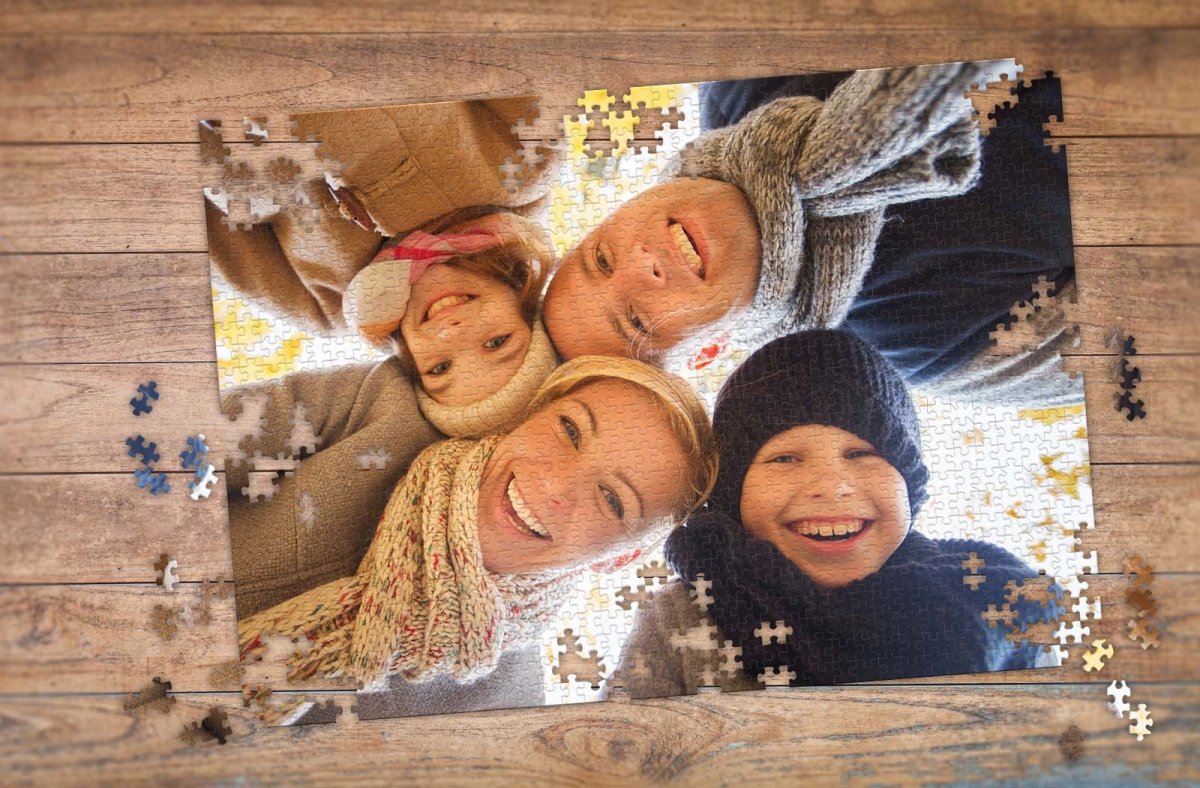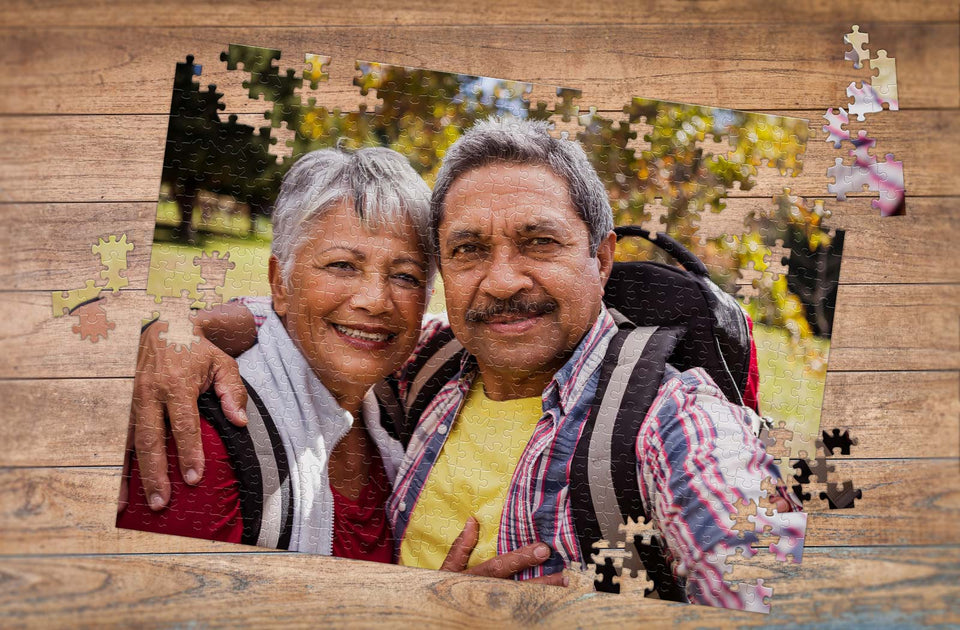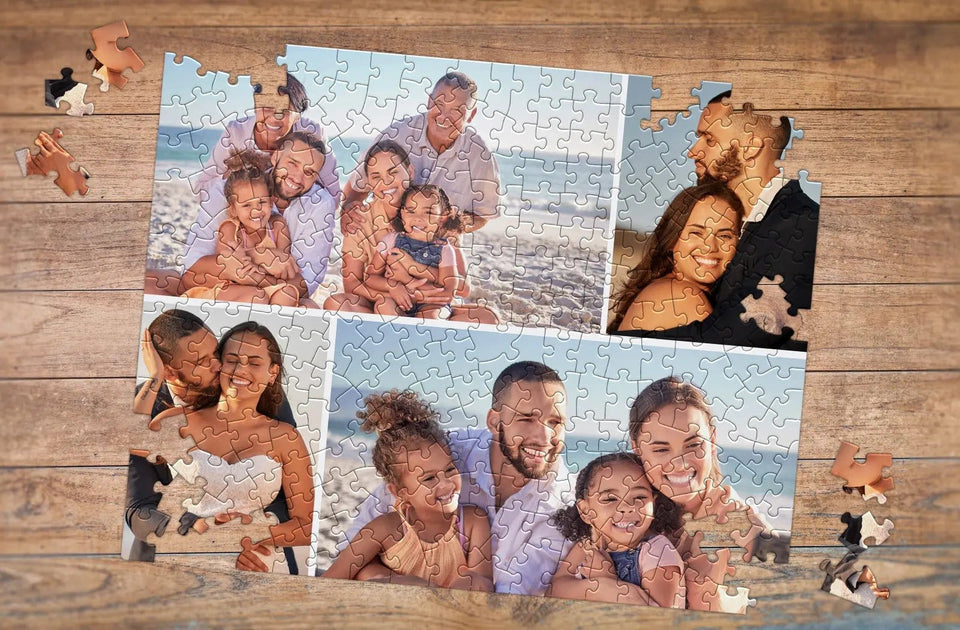How long does a 100-piece jigsaw puzzle take to solve? Several factors determine how long it takes to finish a puzzle. Once you know what they are, you can find the right puzzle for you. Or, if you choose to make a custom jigsaw puzzle, you'll have even more control over these elements. Let's look at how long it'll take you to solve a 100-piece puzzle.

How Long Does a 100-Piece Jigsaw Puzzle Take?
A 100-piece puzzle generally takes a single person between 1 and 2 hours to solve. However, many factors can impact your completion time.
Here are some general estimates for the time it takes to complete various-sized puzzles. (For dimensions' specifics, consult a puzzle size chart.) These time estimates assume only one puzzler working at a time:
- 50 pieces: 30 minutes to 1 hour
- 100 pieces: 1-2 hours
- 250 pieces: 2-4 hours
- 500 pieces: 4-8 hours
- 750 pieces: 6-12 hours
- 1,000 pieces: 10-16 hours
- 1,500 pieces: 12-20 hours
- 2,000 pieces: 14-24+ hours
Factors That Impact How Long It Takes to Finish a Puzzle
Several factors can impact the time it takes to finish a puzzle. Here are several variables to consider when you're trying to find the right puzzle size:
Level of Difficulty
The complexity of the puzzle's image can significantly extend the time needed to complete it. For instance, puzzles with many similar colors or repetitive patterns are harder to solve than those with distinct, easily recognizable features.
Skill Level
Experienced puzzle solvers tend to finish puzzles faster than beginners. As you become more proficient, you will develop strategies that help you identify and place pieces more efficiently, allowing you to complete puzzles quickly.
The Puzzle Image
A picture featuring precise details and edges in contrasting colors can be easier to solve than a landscape or an abstract painting.
Size of the Puzzle Pieces
Puzzles with large pieces can take less time to finish since the fit of the pieces is more pronounced. A puzzle with smaller pieces requires more attention to detail.

Shape of the Puzzle Pieces
Manufacturers cut puzzle pieces into many different shapes: Grid-cut, strip-cut, ribbon-cut, and random-cut pieces. Some people find that random-cut puzzles take longer because there isn't a pattern to follow. In contrast, others say random-cut puzzles are easier since each piece has a distinct shape, hinting at its proper placement. Consider your own puzzle-solving style.
Color of the Pieces
The ability to sort the pieces by color can make a puzzle easier to solve. For example, suppose the puzzle has different-colored pieces you can easily separate into piles. In that case, you can sort and assemble it quickly.
3 Tips for Working on a Jigsaw Puzzle
Setting yourself up for success can make solving a puzzle a more enjoyable experience. Here are a few tips to get you started:
Use Adequate Lighting
You can solve a puzzle more efficiently by seeing the pieces clearly. Lamps off the side can cast shadows over some pieces, making them harder to see. Set up your workspace in a well-lit area with bright overhead lights.
Find a Proper Surface
Spread out your puzzle pieces on a flat, clean surface. A white surface is ideal for seeing the pattern of each piece, but a darker surface can work, too. You can also use a puzzle mat.
Work Methodically
Start a puzzle by turning all the pieces right-side up. Next, separate the border pieces and put them together first. Work your way inward until you complete the puzzle. If you can't find a particular piece, move on and return to it later.
The Benefits of Solving Puzzles
Working on jigsaw puzzles offers numerous cognitive and mental health benefits. Whether you're solving puzzles solo or with friends and family, the benefits extend far beyond just passing the time:
Improves Problem-Solving Skills
Solving puzzles enhances your ability to think critically and find solutions. You develop strategies, practice patience, and improve your attention to detail as you work through the puzzle.
Boosts Memory
Puzzles engage both short-term and long-term memory. Recalling shapes, colors, and places where pieces might fit can help strengthen memory over time. Studies have also shown that solving puzzles may protect against cognitive aging.
Reduces Stress
Focusing on a jigsaw puzzle allows your mind to relax and meditate. The repetitive nature of sorting and fitting pieces can help reduce anxiety and stress, providing a sense of calm.
Encourages Social Interaction
Working on a puzzle with others encourages communication and teamwork. It's a great way to bond with friends and family, building connections while working toward a shared goal.
Enhances Focus and Concentration
Solving puzzles requires intense focus, which can help improve your overall concentration skills. Whether you complete a quick 100-piece puzzle or tackle a challenging 1,000-piece puzzle, your brain gets a workout.
How to Preserve Your Puzzle
After completing your 100-piece puzzle, you can either dismantle it for future use or preserve it. Many choose to frame and hang their puzzles. To make the image permanent, use puzzle-preserving adhesive. Peel-and-stick adhesive backings are a cleaner, hassle-free option compared to glue and keep your puzzle intact for years.
Frequently Asked Questions
How fast can you do a 100-piece puzzle?
A 100-piece puzzle typically takes between 1 and 2 hours to complete, depending on its difficulty and your experience.
What age is a 100-piece puzzle appropriate for?
A 100-piece puzzle is generally suitable for children aged 5 and older. However, the size of the puzzle pieces is a significant factor.
How long should a 200-piece puzzle take?
A 200-piece puzzle can take 2 to 3 hours, depending on the solver's skill level.
How long does it take to finish a 1,000-piece puzzle?
A 1,000-piece puzzle can take 7 to 12 hours or longer, depending on its complexity and your experience.









